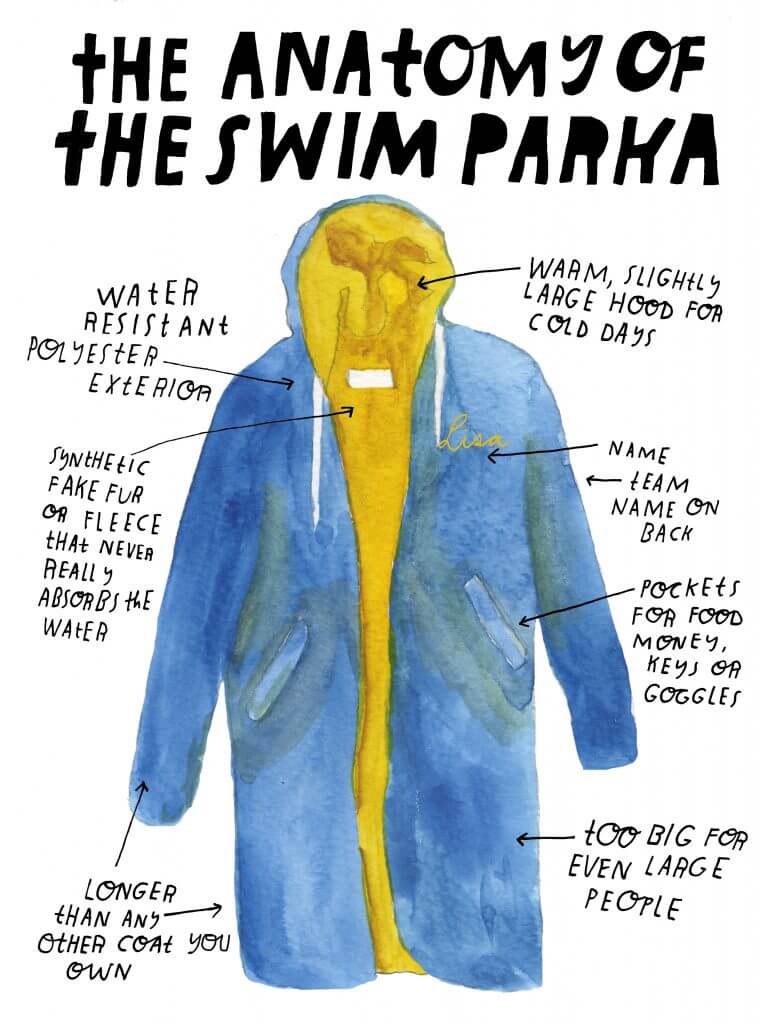Congdon’s “The Joy of Swimming”: An Artful Salute to Our Sport

By Annie Grevers, Swimming World Staff Writer
With a cover as inviting as your backyard pool on a sweltering summer day, you’ll want to cannonball into Lisa Congdon’s “The Joy of Swimming.” Every swirling line, intricate letter, and stroke of water color that make up this book were done by Congdon’s disciplined hand. This is the sixth book created by Congdon, but this is different than any other she’s penned/painted.
An avid splasher in California summers, Congdon swam through her youth, then decided she preferred sleep to early morning practice in high school. At age 16, Congdon suffered a serious knee injury in a skiing accident— doctors prescribed swimming to regain muscle mass. Congdon fell in love with the water once again. She swam competitively her senior year in high school, then went off to college, where her second swimming hiatus commenced.

Photo Courtesy: Christopher Dibble
In 1996, at age 28, Congdon discovered Masters swimming. Over the next 11 years, Congdon traveled the world to compete in Masters meets.
“Before I discovered art, swimming was most of my life outside of my job from 1993 to 2006,” Congdon said. She did not pick up a paintbrush until the age of 31, when she took a painting class to decompress from her day job. Now, at age 48, she is a full-time artist.
Leann Shapton’s book “Swimming Studies” led Congdon to begin drawing parallels between art and swimming.
“They both require enormous discipline and a unique form of endurance,” Congdon says. “Both are rigorous, but also a form of play.” Congdon has been amazed by the number of her artist friends who have swimming penciled into their daily routine.
WHAT’S INSIDE?

Photo Courtesy: Lisa Congdon
Congdon injects her art into every page— watercoloring infographics on topics such as the evolution of the bathing suit, common backyard pool shapes, and the fascinating rules of public pools in Paris, Japan and Iceland. Other pages entertain and educate readers on Olympic “firsts,” quirky facts on each stroke, the anatomy of the swim parka (we’ve never seen it dissected before), the most gifted canine swimmers, the science of swimming, how fast humans are compared to other mammals in water, and the ancient history of the swimming pool. Just as the water can be enjoyed at any age, Congdon’s book can be delighted in at any page.
A foreword by accomplished open water swimmer and author, Lynne Cox, sets the tone for what’s meant to be a nostalgic, inspiring, creative space.
“I wanted the book to illicit a range of experiences and feelings— courage, discipline, accomplishment, free spiritedness, play, summertime, friendship and camaraderie,” Congdon said. “Mostly I wanted the book to help people feel a sense of nostalgia and love for swimming.”
Congdon put out a call for subjects on her blog and stories flooded in. She knew that swimming had been her safety net when life felt like a free fall, but she was profoundly moved by the emotional attachment so many people had with the water. Swimming had saved so many lives in moments of despair.
Vignettes on passionate swimmers (ages 9 to 92) are accompanied by a detailed watercolor depiction of each subject. Congdon had a research assistant for fact finding, but she was the sole artist responsible for hand painting the 140-page book. “There were definitely days when I thought, ‘Why did I agree to hand paint all of the illustrations?’” But when Congdon received a hard copy in January, she knew it was all worthwhile.

Photo Courtesy: Lisa Congdon
A few of the featurettes share the important role of swimming in the lives of familiar Masters swimmers like Karlyn Pipes, Jeff Commings, and Kimberley Chambers. But most subjects are not swimming celebrities.
“It was important that the book was about the power of swimming in the lives of regular people who happen to swim; for whom swimming is a source of feeling power and joy,” Congdon says. “I wanted the book to reflect the diversity of the swimming community— black and white, young and old, gay and straight, able and disabled.”
The book’s short stories all point to water as the great equalizer. Some of the book’s most poignant words on water come from Congdon’s introduction:
“It allows the awkward to move with grace, the heavy to feel light, and the disabled to feel accomplished. It is an emotional blanket in times of recovery and vulnerability. It is a form of movement that supports us no matter how large or small we are, how tall or short, how able-bodied or disabled.”
Featured swimmer Chel Micheline, who was born with a neurological disease called spina bifida, swims every day unless there is a hurricane preventing her from getting to the pool (that actually happened). Chel finds her inner warrior everyday in the water, where she does not feel at the mercy of her disease. Dwarfism, cerebral palsy, or paraplegia make certain tasks more difficult for other subjects, but when they slip into the water, movement is free and easy.
Just as museum-goers stare at a piece of art and have a unique emotional reaction, swimmers have a distinct emotional reaction to the sensation of moving through water. Everyone’s relationship with swimming is different, and that’s part of the reason this book’s hodge podge of colors, facts, and stories feels just right. Swimmers are a motley crew, from a wide range of backgrounds— but when it comes to sharing our love and appreciation for the water, we’re all the same.




Kudos, Lisa! Hope your mom’s doing well! xoxo <3